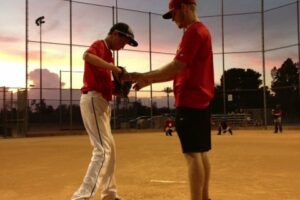At MADE Baseball, we encourage our players to pay attention to details, from the very beginning of their baseball journey. Much of the knowledge we aim to pass on to our players in order to help them develop and grow in the most positive ways possible simply comes from conscious language and being mindful of how we phrase the things that we say and teach. I had the pleasure of shooting the video down below with my good friend, Coach John Madden from YouGoProBaseball.com. He has been making epic baseball videos for years that have been helping players all over the world and has a pitching program for young pitchers as well.
The first thing that any young player does when they start playing baseball or softball is normally throwing. It could be hitting also, but the first thing that they will be doing every practice throughout their baseball career is going to being throwing a baseball to “get warmed up.” Going through my throwing/warm-up routine was always one of my favorite parts of practice. I always loved the process of getting my arm loose and working to perfect my technique and/or craft. I was a pitcher from the age of 12 and I always wanted to be pitching. I loved imitating the various pitching motions of the guys I watched in the big leagues like Tom Glavine and Greg Maddox, among many others. I loved challenging myself to feel out what I needed to do with my mechanics to mimic them as much as I could.
As I grew up and played into high school I always remembered my coaches saying “Go warm up” rather than phrasing it as something with more intent and purpose like “Go throw for 15 minutes, and make sure that you work on your mechanics.” It wasn’t until junior college that my pitching coach took all of the pitchers and instructed us through a specific pitcher’s throwing program drill by drill to help us build our mechanics and work on specific pieces of our motion. Having this programatic way of doing things and going through your routines should also apply to all positions, not just pitchers.
If you are an infielder, you should be thinking about simulating the footwork, glove work, and arm action that you will have at your infield position. If you are an outfielder, you should be working on your crow hops, getting rid of the ball quickly, thinking about where you catch the ball relative to the positioning of your body, ie: catch it near your arm side ear. As a first baseman, you might be working on how you stretch to receive the ball, or taking some reps to be organizing your footwork as if you are trying to turn a double play to second base, whether you are a right handed or left handed first baseman. Lastly, as a pitcher, it will help your game far greater to actually be working on as many facets of your mechanics and wind up as you possibly can. For example, working on your change up throughout your throwing routine. Also, working on how you come set, your slide step motion, the amount of time you are pausing when you come set, head fakes, pick offs, off speed pitches, four seam fastball, two seam fastball, and maybe trying small variations of your different pitch grips to see what feels the best and really works the best for you.
The main idea of this post is to make sure that as coaches we are mindful of the way we present the information that we are teaching to our players. It will take time and focus from the coaching side, but it will pay off big dividends to your team and your individual players with consistency and routine. It needs to be communicated clearly from the very beginning of the season and the beginning of your players baseball journey. This mindset of clear communication applies to all facets of life and it applies to all humans of all ages. How we say what we say and the way that we phrase the things that we are communicating can quite literally be the difference between success or lack there of. As coaches, we are motivators, and it is our job to be working on the efficacy of our communication. Just like our pitchers should be trying different little variations of their pitch grips or their slide step, we as coaches should be trying different communication styles and phrasing combinations to see what works the best. Always sharpening the sword, always thinking like a champion, in all ways, EVEryday, the best we can, nothing less. This is the blood circulation, this is the Mantra, this is #GettinMADE.
Simply put, don’t tell your players to “go warm up”, tell them(starting at tee ball) to work on their technique and try their best to improve a little bit that day during their throwing program because someone is always watching.




